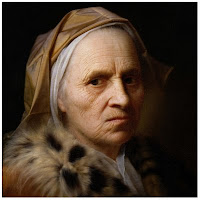Thursday, September 2nd, 2010
Handel as Art Collector
 George Frideric Handel (shown on right in a portrait (1726-28) attributed to Balthasar Denner) is one of my favorite Baroque composers. And it’s not only his music that I like: the more I learn about things related to Handel (such as his passion for food (so much that he withheld fine food from guests in his home), or even seemingly unrelated things, like the fact that he and Jimi Hendrix could have been next-door neighbors), the more I am intrigued by him.
George Frideric Handel (shown on right in a portrait (1726-28) attributed to Balthasar Denner) is one of my favorite Baroque composers. And it’s not only his music that I like: the more I learn about things related to Handel (such as his passion for food (so much that he withheld fine food from guests in his home), or even seemingly unrelated things, like the fact that he and Jimi Hendrix could have been next-door neighbors), the more I am intrigued by him.
Hence, I became helplessly distracted this afternoon when JSTOR’s unreliable search engine brought up Thomas McGeary’s article “Handel as Art Collector: Art, Connoisseurship and Taste in Hanoverian Britain” (when I had typed in keywords to search for medieval illustrations of French queens).
 It was interesting to learn that Handel was a prolific art collector. He was recorded to have “taken great pleasure in contemplating the works of art” in his collection.1 I really enjoyed learning about the nature of his collection, too. Despite the fact that Victorians praised Handel for his biblical oratorios, the composer had few biblical works of visual art.2 Instead, Handel was drawn to more landscapes, Dutch/Flemish paintings, French classical painters (e.g. Poussin), and a handful of Italian artists. Handel didn’t care too much for portraits of individuals (which is unusual, since portraiture was so popular in England at the time), and it appears that he even gave away all portraits of himself. He did, however, have two pictures of heads by Balthasar Denner, one of which may have resembled Denner’s Portrait of an Old Woman (before 1721, shown above left).
It was interesting to learn that Handel was a prolific art collector. He was recorded to have “taken great pleasure in contemplating the works of art” in his collection.1 I really enjoyed learning about the nature of his collection, too. Despite the fact that Victorians praised Handel for his biblical oratorios, the composer had few biblical works of visual art.2 Instead, Handel was drawn to more landscapes, Dutch/Flemish paintings, French classical painters (e.g. Poussin), and a handful of Italian artists. Handel didn’t care too much for portraits of individuals (which is unusual, since portraiture was so popular in England at the time), and it appears that he even gave away all portraits of himself. He did, however, have two pictures of heads by Balthasar Denner, one of which may have resembled Denner’s Portrait of an Old Woman (before 1721, shown above left).
It also is apparent that Handel bought works of art simply because he liked them; he doesn’t give one the impression of a hard-nosed collector who is interested in owning works by all major artists and schools, nor was he interested in collecting works by the Old Masters. He also didn’t follow the contemporary craze to purchase works by William Hogarth, even though Handel might have known Hogarth personally. Instead, Handel did “his own thing” when it came to art collecting, which (I think) indicates an aspect of his personality that translates into his musical compositions: instead of closely following musical trends, Handel created his own musical style (which I think is instantly recognizable). He wrote music that appealed to him, just as he collected art which he found appealing.
1 Thomas McGeary, “Handel as Art Collector: Art, Connoisseurship and Taste in Hanoverian Britain,” Early Music 34, no. 7 (2009): 533.
2 McGeary lists the few biblical works that Handel owned: Hagar and the angel, the finding of Moses, prints of rest on the flight into Egypt, a Guido Reni altar-piece and possible a pair of biblical prints. McGeary suggests that the lack of biblical scenes could be due to a Protestant fear of idolatry. It is interesting to see McGeary’s comparisons of Handel’s collection with other collections, which have large numbers of biblical scenes (approximately 27-33% of the collections mentioned). See Ibid., 533-576.





